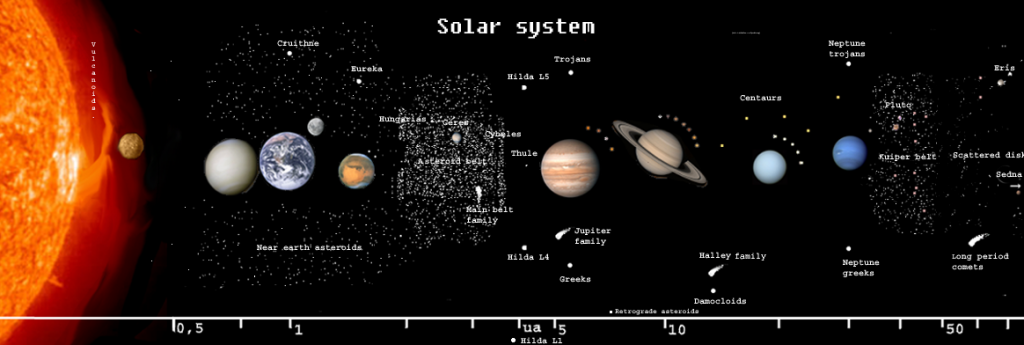Scientist find new evidence for Solar System’s ninth planet
After the demotion of Pluto, the Solar System was left with only eight planets but last year, a scientific announcement made headlines again as researchers said that there found evidence of another ninth planet. While the observations that led to this conclusion were called into question, a new study form Spain says that it found additional proof that the Solar System might have nine and not eight planets after all.
Public opinion struggled with the demotion of Pluto as the ninth planet of the Solar System lost its status and was demoted, becoming a dwarf planet. It wasn’t only Pluto’s “destiny” that people were concerned about but also the loss of the seemingly symbolically-perfect number nine that governed our universe.
For all the fans of number nine, 2016 was a great year. Astronomers announce that the Solar System could be home to nine and not eight planets. But the observations that led to this conclusion were called into question as additional analysis showed biases in the observational data were detected.
But now a new study, based on a novel technique to analyse the orbits of the so-called extreme trans-Neptunian objects, provides additional support to the theory of the nine planet Solar System.
Two Spanish astronomers, from the Complutense University of Madrid, applied a new method that eliminates observational bias in order to find out if indeed there is an unknown planet out there, exerting its influence on the trans-Neptunial objects.
After looking at the most extreme TNOs, those located at average distances greater than 150 AU and that never cross Neptune’s orbit, the calculations show that there should be a planet out there, somewhere beyond Pluto. The astronomers specifically looked at nodes, the two points at which the orbit of an ETNO, or any other celestial body, crosses the plane of the Solar System. These are the precise points where the probability of interacting with other objects is the largest, and therefore, at these points, the ETNOs may experience a drastic change in their orbits or even a collision.
“If there is nothing to perturb them, the nodes of these extreme trans-Neptunian objects should be uniformly distributed, as there is nothing for them to avoid, but if there are one or more perturbers, two situations may arise,” explains Carlos de la Fuente Marcos, one of the authors, to SINC. “One possibility is that the ETNOs are stable, and in this case they would tend to have their nodes away from the path of possible perturbers, he adds, but if they are unstable they would behave as the comets that interact with Jupiter do, that is tending to have one of the nodes close to the orbit of the hypothetical perturber”.
The Spanish astronomers analyzed the nodes of 28 ETNO’s and found correlations where none should be present, between the positions of the nodes and the inclination, one of the parameters which defines the orientation of the orbits of these icy objects in space.
“Assuming that the ETNOs are dynamically similar to the comets that interact with Jupiter, we interpret these results as signs of the presence of a planet that is actively interacting with them in a range of distances from 300 to 400 AU,” says De la Fuente Marcos, who emphasizes: “We believe that what we are seeing here cannot be attributed to the presence of observational bias”.
As until now, the theory of the ninth planet has largely been disputed due to observational bias, the astronomers focused their attention on nodes because they depend on the size and shape of the orbit, parameters which are relatively free of observational bias.
“It is the first time that the nodes have been used to try to understand the dynamics of the ETNOs”, the co-author points out, as he admits that discovering more ETNOs (at the moment, only 28 are known) would permit the proposed scenario to be confirmed and subsequently constrain the orbit of the unknown planet via the analysis of the distribution of the nodes.
Signs of a tenth planet
And the ninth planet could not be the only recent discovery to modify our Solar System models. Also applying data mining to the orbits of the TNOs of the Kuiper Belt, astronomers Kathryn Volk and Renu Malhotra from the University of Arizona (USA) have found that the plane on which these objects orbit the Sun is slightly warped, a fact that could be explained if there is a perturber of the size of Mars at 60 AU from the Sun.
“Given the current definition of planet, this other mysterious object may not be a true planet, even if it has a size similar to that of the Earth, as it could be surrounded by huge asteroids or dwarf planets,” explains the Spanish astronomer, who goes on to say: “In any case, we are convinced that Volk and Malhotra’s work has found solid evidence of the presence of a massive body beyond the so-called Kuiper Cliff, the furthest point of the trans-Neptunian belt, at some 50 AU from the Sun, and we hope to be able to present soon a new work which also supports its existence”.
